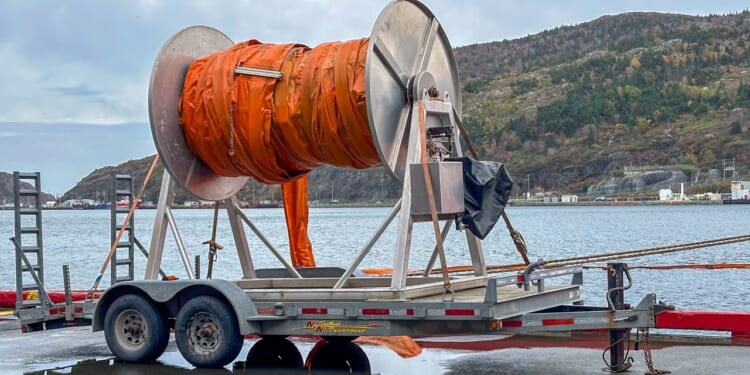The US Navy’s efforts to develop “distributed acoustic sensing” capabilities have included experimental trials on the West Coast.
More global communication travels under the seas than via satellites today. There are more than 600 active and planned submarine communication cables crisscrossing the world’s oceans, with new ones being added constantly. These cables serve as the backbone of the Internet, with fiber optic cables stretching more than 750,000 miles.
In addition to sending information around the globe, a new technology could enable the same cables to track the movements of an adversary’s submarines.
A Brief History of Undersea Cables
The first transatlantic cable—then made of copper rather than fiber optic—went online in August 1858, reducing the communication time between North America and Europe from around 10 days on average to just several hours. Although that cable eventually failed, it was significantly upgraded less than a decade later. For nearly a century, undersea cables had a monopoly on international communication—until Telestar 1, the world’s first communication satellite, went into orbit in 1961.
Because so much data, including classified information, is transmitted via undersea cables, they have become targets for espionage. During the Cold War, as part of the top-secret “Ivy Bells” mission, US Navy divers successfully installed a listening device on a Soviet cable in the Sea of Okhotsk. It remained undetected until a traitorous NSA employee revealed the program to Moscow in 1981.
Today, satellites aren’t just used for sending communications; they are a critical component of intelligence gathering, acting as a literal eye in the sky. Soon, undersea cables could fill a similar role.
What Is “Distributed Acoustic Sensing”?
A new technology, known as “Distributed Acoustic Sensing” (DAS), could transform the hundreds of thousands of miles of cables into passive sonar arrays, which would be able to detect, classify, and even track submarines and other undersea activity.
“DAS works by using standard fiber-optic cables as long chains of acoustic sensors,” Interesting Engineering explained. It added that by sending a pulsed laser through the cable, “tiny backscattered signals vary based on vibrations or stress caused by nearby sound waves,” which can be analyzed by advanced algorithms to detect patterns. That can eventually be used to determine if natural events, such as undersea seismic activities, or mechanical sources, like a submarine’s propeller, created the waves.
Beyond being a massive “real-time monitoring system,” which can literally listen to thousands of miles of ocean, it promises to be cheaper to operate than “traditional sonar systems or hydrophone networks.”
America Is Testing Undersea Detection Technology
Nations that have coastal territory and rely on undersea cables are leading the efforts. The United States Navy’s efforts have included experimental trials on the West Coast, while it is now working to integrate the technology into operational undersea cables.
“The US is testing the fusion of DAS feeds with data from P-8A Poseidon maritime patrol aircraft and undersea drones, exploring how AI can enhance detection capabilities across the Pacific,” Interesting Engineering added.
Similar programs are underway in the UK, the Netherlands, Norway, and Germany. That has included tests in the North Arctic Seas.
Development of the DAS technology is also being undertaken as part of the trilateral AUKUS military alliance between Australia, the UK, and the US. Those efforts could include integration between unscrewed undersea vehicles (UUVs) and the DAS, as well as the creation of “a shared undersea surveillance grid across the Indo-Pacific.”
That would likely allow for the tracking of Chinese and Russian submarines in those waters.
Russia and China Have Their Own DAS Programs
There is already speculation that China and Russia are developing similar DAS capabilities, both for surveillance and anti-tampering efforts. Cables that can detect the movement of submarines would be much harder to tap.
Moscow has been critical of the technology, suggesting any NATO network of DAS-enabled undersea cables would threaten its strategic submarines.
However, the technology is still in its infancy. While it may be more cost-effective than traditional sonar-based systems, the ocean is vast, and modern submarines are designed to be very quiet. There are already concerns that efforts could be made to “jam, spoof, or map DAS-enabled cables.”
The most significant advantage remains its ability to employ existing infrastructure, turning communication cables into underway sensors in some of the already highly disputed regions of the world.
About the Author: Peter Suciu
Peter Suciu has contributed over 3,200 published pieces to more than four dozen magazines and websites over a 30-year career in journalism. He regularly writes about military hardware, firearms history, cybersecurity, politics, and international affairs. Peter is also a contributing writer for Forbes and Clearance Jobs. He is based in Michigan. You can follow him on Twitter: @PeterSuciu. You can email the author: [email protected].
Image: Shutterstock / Dolores M. Harvey.


















